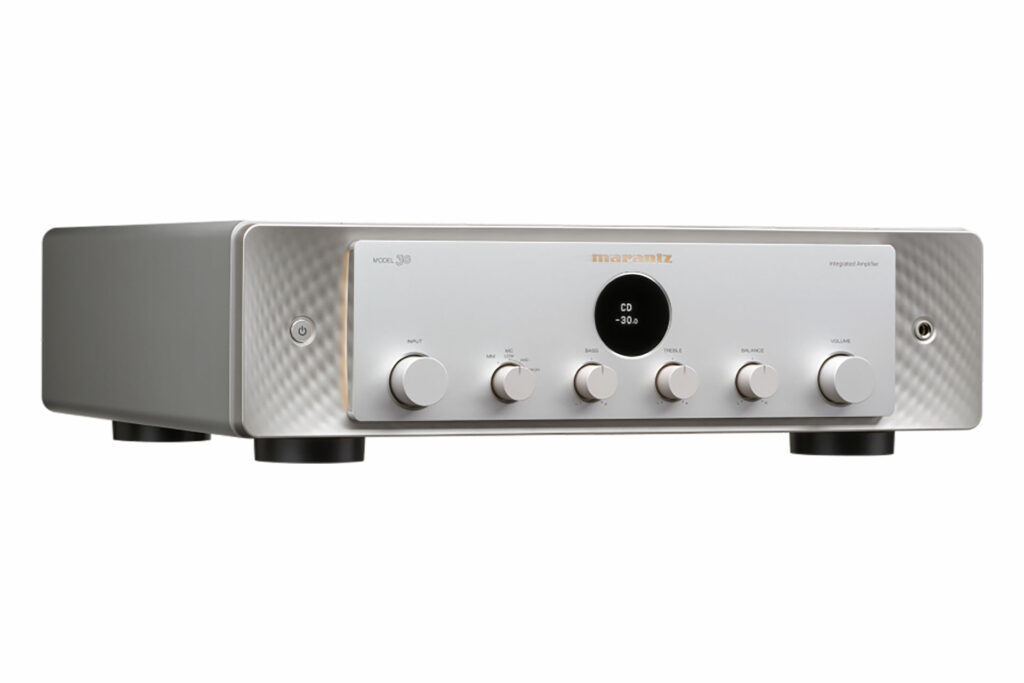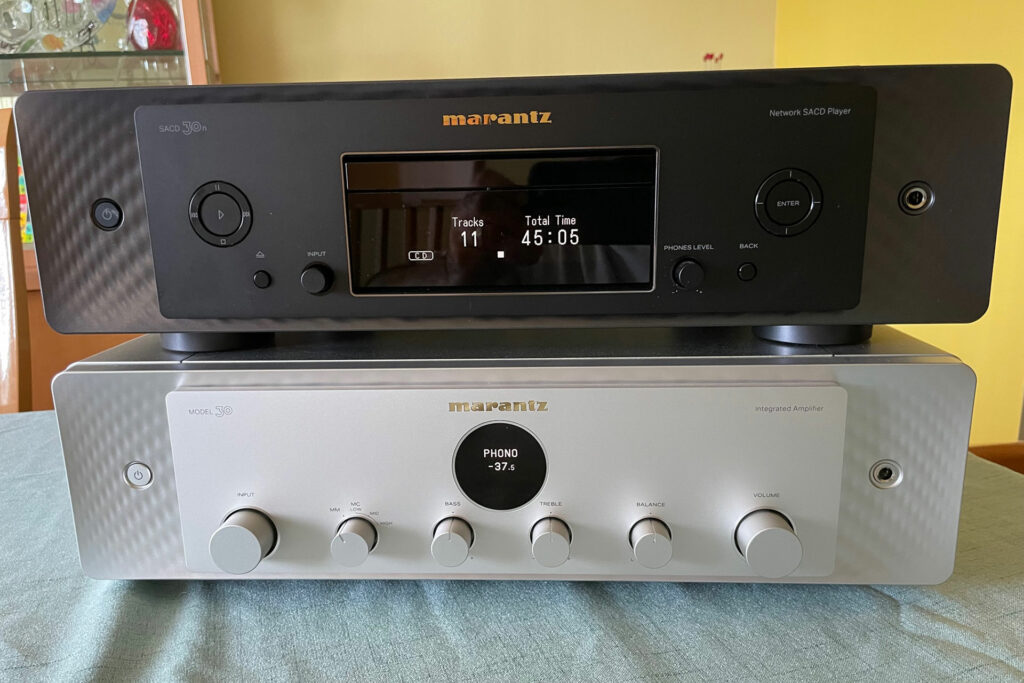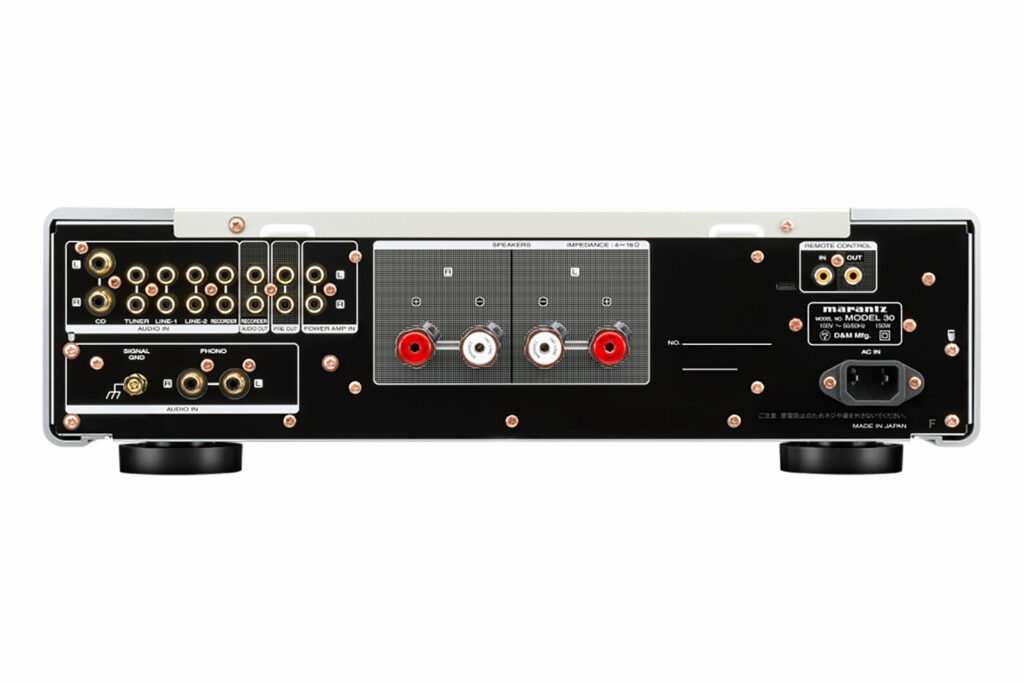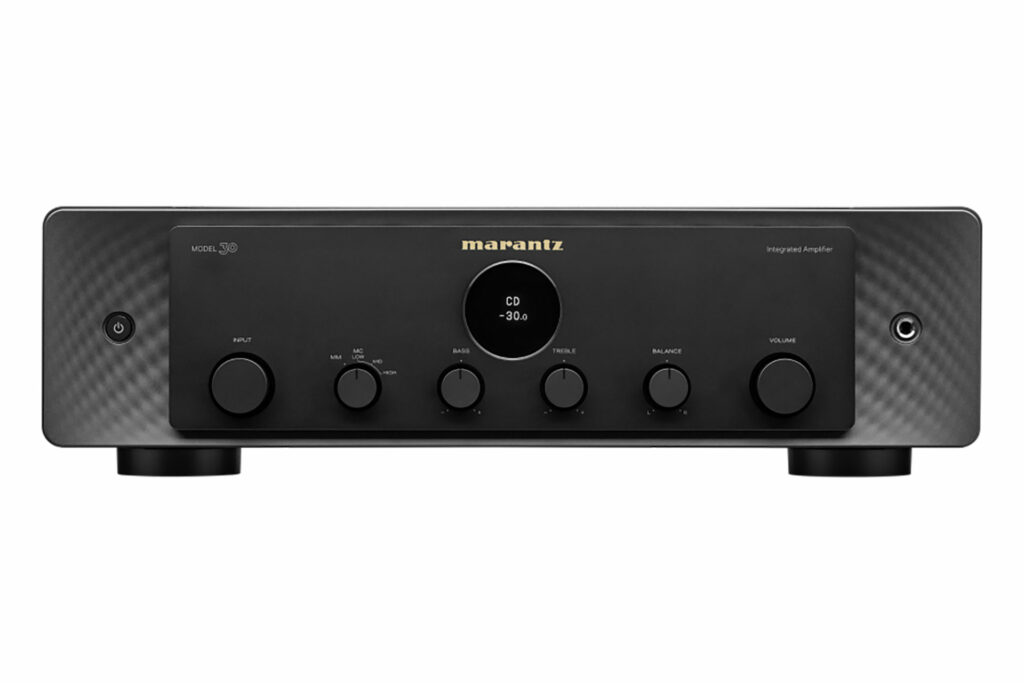Marantz’s Model 30 integrated amplifier ($2,999 buy at Crutchfield) has a blend of old-school features and design with modern technology, but perhaps not in the way most audiophiles might anticipate. The Model 30 has a classic, old-school interface and feel, blended with modern aesthetics and audio technology. At $2,995, it’sa viable alternative to separate audiophile amplifiers and stereo preamps that keeps things simple but sounding really good. Is this the right bit of Japanese audiophile gear for you? Let’s find out.

What Makes the Model 30 Integrated Amplifier Special?
- The Model 30 is carefully built in Marantz’s Shirakawa Audio Works facility in Japan in an era where many products like this are made in China or Vietnam. This facility houses engineers as well as many employees with close to 40 years of experience.
- The first thing I noticed when I saw the Marantz Model 30 was its striking industrial design. It’s available in either silver gold or black finish. While black is likely to outsell silver based upon versatility, the silver/gold is a warm silver tone that provides a clean-classic look, especially when matched with the Marantz Model SACD 30N SACD player The familiar porthole from Marantz’s iconic legacy components is front and center on a floating aluminum panel, flanked by gently curved side panels that have elongated dimples reminiscent of those on a golf ball or a tufted fabric. Adjustable lighting behind the floating panel makes for a nice, classy presentation in a darkened room. For those of you who do not like it, the lighting is defeatable.
- The Marantz Model 30 integrated amp has a real, legitimate phono stage, not an afterthought thrown in from a receiver. Marantz utilizes their Premium Phono EQ circuit for both MM/MC cartridges.
- The Model 30 is powered by a Class-D Hypex NC500 amplifier models providing 100 watts per channel into eight ohms and 200 watts per channel into four ohms. The power supply is a hefty, enclosed toroidal unit just for the amplifier section; a separate power supply is supplied for the preamplifier section. Total harmonic distortion is stated as .005 percent at 1kHz, eight ohms.
- Those familiar with Marantz will not be surprised to learn that there are custom HDAM-3 modules. The Model 30 was tuned by the “Marantz Sound Master” (their term – not mine) to achieve the desired voicing with a system that also utilizes fully discrete circuits, wide-range current feedback in the preamplifier, and linear volume control.
- While I expected to see a balance control, the treble and bass tone controls are a bit retro, but I do like them. Those who are into it can use them. Purists can defeat them. Your call.
- The back panel has five line-level inputs, a power amplifier direct input, phonograph input, and recording input/output loop, and one output. All terminals are single-ended with the CD and phonograph inputs being made of a more substantial, machined-brass terminals. The back panel also features beefy five-way binding posts, remote control terminals, and an IEC power plug port. Lastly, the remote control is one of Marantz’s newer designs that uses more metal and has a more substantial feel.
- Despite the Marantz Model 30’s modest chassis dimensions of 17.4 inches wide by 5.1 inches high and 17 inches deep, it weighs in at 32.3 pounds. The chassis feels sold and extremely well built, I suspect the triple-layer chassis and multiple power supplies play a large role in this.
Why Should You Care About the Marantz Model 30 Integrated Amplifier?
The hand-curated nature of this Japanese design harkens back to the days when Marantz was the highest-end audiophile brand on the market. At $2,999, the Model 30 is far from the most expensive integrated amp on the market today, but it is a gorgeous, simple, easy-to-use audiophile component that sounds very good. At its price and considering its advantages, it will appeal to many in the hobby as a good place to land when it comes time to make an investment in audiophile electronics.

Some Things You Might Not Like About the Marantz Model 30 Integrated Amplifier
- The Marantz Model 30 is not feature-rich like others options in the category. There is no room correction, bass management/subwoofer output, app control, HDMI connectivity, or streaming end point. Yes, there is new technology in the audio circuits, but the feature set is classic, old school.
- There are no balanced inputs in the Marantz Model 30. I know many will be pairing this piece with Marantz’s SACD 30N, which also does not have balanced outputs, but this could be problematic if you were looking for something to use with your favorite balanced sources.
Listening to the Marantz Model 30 Integrated Amp…
I have been reviewing several inexpensive turntables with Moving Magnet cartridges and found the phono stage in the Marantz Model 30 to be very good. Speakers used were Starke IC-H1 and Scansonic HD M20.
Listening to Queen’s “We Will Rock You” from their Greatest Hits album via the Pro-Ject Debut Carbon EVO ($599 buy at Crutchfield), I found the music to be dynamic and very engaging. The voices and instruments were both full bodied and neutral sounding. The drums were solid, and the combination of components provided layers of detail, making for a more realistic and enjoyable listening experience.
I used the Marantz SACD 30N as the source for most of my listening, including the sessions discussed below. While not directly related to sound quality, but part of the overall experience, the Marantz SACD 30N and Model 30 both share the same aesthetics and can have their lighting set the same to make for an attractive stack. The same remote can control both, reducing clutter and complexity.
Listening to Eric Clapton’s “Layla” from The Lady in the Balcony (Qobuz, 96 kHz), the Marantz integrated amp did a great job capturing the detail in Clapton’s voice. This was bittersweet to hear how much his voice has changed over the decades. The differences in his voice in this recording and the earlier versions were clearly reproduced. Listening to this track through the Marantz Model 30 placed Clapton in between and slightly behind the speakers, with an overall soundstage that extended horizontally slightly beyond the speakers. Overall, there was a slight warmth in the midbass that added a bit of weight or fullness but without any apparent obscuring of detail.
I wanted to explore bass performance a bit more, so I listened to Billie Eilish’s “Therefore I Am” (Qobuz, Hi-Res/44.1 kHz) with Marantz driving the Scansonic HD M20 speakers. This track uses a lot of synthesizers and processing but also a strong bass track that that the Marantz handled with ease even at higher volumes. No, the Scansonic’s do not provide a lot of bass below 50 Hz, but the Marantz provided plenty of control to keep the bass full bodied at louder volumes. Just as importantly, there was no compression or harshness throughout the entire sonic experience.
Does the Marantz Model 30 Integrated Amplifier Have Any Resale Value?
Yes. The build quality, the brand legacy, and the strong sonic performance will make the Marantz Model 30 a sought after integrated amp for many years to come. Marantz is also a well-marketed and even better distributed brand, so many people are aware of the product, which helps with resale values too. No, the Marantz doesn’t come with fancy room correction, HDMI, and other tech-forward options, but that likely keeps the unit even more valuable over time, in an odd way, since its connectivity is less likely to become obsolete.

Who Is the Competition For the Marantz Model 30 Integrated Amp?
The Marantz Model 50 at $1,800 (buy at Crutchfield) is feature rich, with a built-in DAC and more connectivity, including HEOS. However, the internal audio components are not as premium as in the Model 30, and if you want to use a Moving Coil cartridge, you’reout of luck as the phono stage is Moving Magnet only.
The NAD M10 V2 at $2,499 (buy at Crutchfield) and Naim Uniti Atom (buy at Amazon) at $3,799 are both worthy options to consider in this space. Neither has a phono input, but both have a well-designed streaming interfaces with sophisticated app control and premium audio components. The Naim also has a headphone output, whereas the NAD does not. Lastly, the JBL SA750 (buy at Crutchfield) features 130 watts per channel of Class G amplification hidden behind its retro styled faceplate, streaming, and Dirac Live room correction.

Final Thoughts on the Marantz Model 30 Integrated Amplifier
With the Model 30, Marantz focused on placing audio performance first, paying attention to basics and sound quality rather than providing a feature-rich product. The Marantz Model 30 integrated amplifier will last a long time and not be outdated with inevitable changes in streaming protocols or room correction. It is seemingly simple things done right that make this product so enjoyable to use.
Human interface with this truly audiophile-grade integrated amp is well executed. The knobs turn smoothly, the connectors on the back are solid and well-made, and the remote is a significant step up from what you would find on most receivers, as is the overall build quality. Photos do not do the design justice, especially with the panel lighting engaged. Saving the best for last, Marantz obtains superior audio quality with the use of custom circuits and the Hypex amplifier modules. This quite a fantastic integrated amp that falls in a goldilocks zone of high-end performance and excellent value, which is something that always grabs our attention in the audiophile world.
.




Beautiful integrated amp. Guess the question for most people is how far have the Hypex Class-D modules come? Are we to the point that they rival Class AB amplifier architecture in sound quality? They must be getting very close.
I agree with your assessment of the value of the amp lasting longer because it is more purist in features so it won’t get “long in the tooth” as quickly as one with a DAC or streamer included. Thanks for the review.
I am expecting an amp review from an upstart called Buckeye Audio that is an affordable Hypex chip design.
I consider that technology part of the new class-D revolution. GaN, Pascal, Hypex. Others. It is changing the audiophile game. It is so “disruptive” that some of the traditionalists can’t believe that the advantages and cost savings. Then again when do the traditionalists ever NOT fight change in this hobby? They ALWAYS DO but things change anyway.
Stay tuned for this Buckeye review. Likely end of 2023 or early 2024. I am expecting the copy this week.
Great Question.
BTW: this Marantz is GORGEOUS. You are right. I’ve played with them in person.
Buckeye may have a great product but I would never buy from a company that doesn’t list its address, phone number or contact information on its website…when companies like Orchard Audio, VTV Amplifier and most others do.
I will talk to them about that as that is bad SEO too.
No matter how good they might be, I’m a bit disappointed that they are using Hypex amplifier modules instead of something built from ground up at that Marantz facility. They already are using a classic design outside, it would have made sense in my eyes to rely on their proven experience in building amplifiers to use their own design. It at least enough to keep me off the future customer list of this amplifer.
I am confused a bit by this comment.
You want an older technology – why? Is older better? Most audiophiles think so but that’s not the case when it comes to today’s amps.
I’ve met the guys from Japan who make this amp and they are SERIOUS engineers. This is a serious product at a very fair price.
I bought an original Model 30 as a HS graduation present to myself. I love that unit and so did my son. 4 years ago I had it completely gone through and recapped and gave it to my son as a College graduation present. It will be in my family for another 50 years!
That defines LONG TERM VALUE!!! 🙂